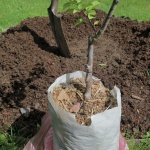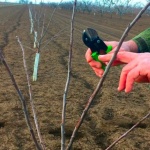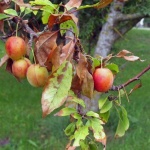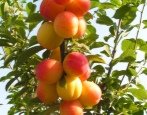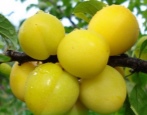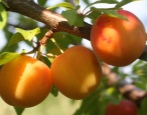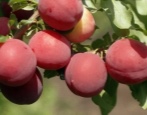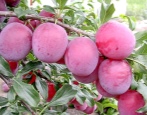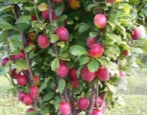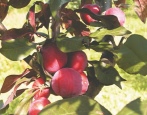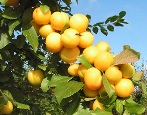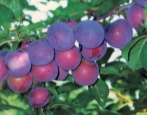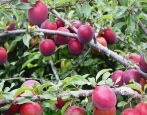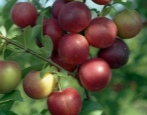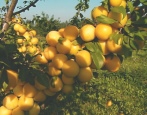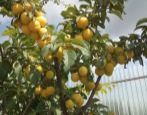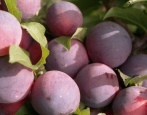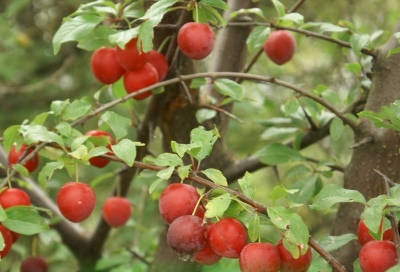
- Authors: G.V. Eremin, S.N. Zabrodin (Crimean experimental selection station of the All-Russian Research Institute of Plant Industry named after N.I. Vavilov)
- Name synonyms: Prunus cerasifera Cubanckaya Kometa
- Appeared when crossing: Chinese plum Early x cherry plum Pionerka
- Year of approval: 1987
- Growth type: undersized
- Ripening period: early
- Self-fertility: partially self-fertile
- Fruit size: large
- Yield: high
- Appointment: for canning, for fresh consumption
Cherry plum Kuban comet is a large-fruited early variety that gardeners like very much. In addition to these characteristics, it is also appreciated for its high yield.
Description of the variety
The Kuban comet is an original culture, perfectly adapted to unfavorable climatic conditions. One plant can bear up to 100 kg of fruit. The branches can sometimes not support the weight and break, so it is recommended to make supports for them. The tree has a flat-round sparse crown, grows up to 2.8-3 m. The trunk is with a smooth surface, gray in color. Leaves are elongated, smooth, juicy green.
The Kuban comet variety has clear advantages: excellent taste characteristics, large fruits, high yield, undemanding soil. The fruits are well transported. Cherry plum is partially self-fertile. However, she has an average level of disease resistance.
Fruit characteristics
The fruits are large, each weighing 30 g. Fruit color ranges from red to burgundy and purple. Fibers of the pulp are of a delicate structure, yellow or golden in color. There is a weak seam on the surface. Resistance to shedding is ensured by a short stem, close to the fruit. Due to the dense skin, the fruits are stored for a long time (up to 25 days). The middle pit is poorly separated from the pulp.
Taste qualities
The fruits of the variety have an original sweet and sour taste with a delicate apricot aftertaste. The fruits are relatively juicy. They also have a pleasant aroma. The variety has gained recognition in cooking. From the fruits, dishes are prepared according to various culinary recipes: jam, juice with pulp, jam, compote, jam, marshmallow, filling for pies, marmalade and much more.
Ripening and fruiting
The fruits ripen by the second half of July. The plant is considered early maturing in terms of ripening. Ripe fruits are firmly held on the branches, and there are practically no cracks on them.
Yield
With proper care, the variety produces rich yields. Up to 100 kg can be harvested from one plant. The yield depends on the age of the tree, care and growing conditions. The average indicator of plants that have just entered fruiting is 30-50 kg. A young tree can bear from 10 kg of fruit.
Self-fertility and the need for pollinators
Cherry plum Kubanskaya is a partially self-fertile variety. To increase the yield, other types of cherry plums can be grown nearby. The most suitable varieties will be Mara, Pramen, Traveler, Gift to St. Petersburg. According to a number of recommendations, the Chinese plum Skoroplodnaya successfully adjoins.
Growing and care
The plant is quite unpretentious to care for. Compliance with simple recommendations will allow you to maintain yield and aesthetically designed appearance. Under favorable climatic conditions, it is better to plant a seedling in the fall. If the region is cool, seedlings should be planted in the spring.
Almost any type of soil is acceptable for the Kuban comet. Grows poorly on swampy and heavy clay soils. The soil should be neutral in acidity.For planting, it is better to choose a well-lit, well-heated and wind-protected place. The ideal option would be the southern slope of the hill, in this case the plant will be protected from the cold northerly winds. With a close occurrence of groundwater, a mound should be prepared for planting with a height of 60-70 cm.
Wells must be formed in advance, a couple of weeks in advance. Their depth is 90 cm. A mixture of humus, superphosphate and potassium sulphide is laid at the bottom. Lime or ash is suitable for deoxidizing the soil of the pit. During the autumn planting, it is better to take manure or humus for feeding.
Choose a suitable seedling (1-1.3 m). There should be no scratches on it, the roots should be moderately branched, swollen buds are allowed on the branches. Broken or dried roots should be cut off. You should choose two-year-old zoned seedlings, they will be better adapted to the conditions created. Before planting, it is necessary to soak the root system in a clay mash (2-3 hours). You can use a root stimulant.
A wooden stick must be driven into a small roller prepared at the base of the planting hole. When placing a seedling, the root collar should be 6-7 cm above the surface. Next, fill the hole and carefully compact the soil. The tree should be tied to an installed stick. Pour well with 20-30 liters of water.
The subsequent care of the plant is uncomplicated. Initially, young plants are watered 6-7 times a season, then 3-4 times. Due to the fact that the root system of the variety is superficial, the soil must be moistened to a depth of 35-40 cm. The frequency of watering also depends on the frequency of precipitation; waterlogging must not be allowed.
Fertilizing is simple. Apply fertilizers with nitrogen in the spring, with phosphorus and potassium in the summer. Once every 2-3 years, carry out autumn or spring fertilizing with organic fertilizers. Loosen the soil around the plant regularly to ensure optimal air exchange and prevent compaction.
Correct crown formation contributes to giving a decorative appearance, and also ensures an increase in yield. For this variety, you should not make a leader formation of the crown, since the tree may freeze. Such shaping implies an even distribution of skeletal branches at a considerable distance and cutting of the main conductor.
The shape of the crown when pruning is chosen based on the climatic characteristics of the area. In warm regions, the best option would be the shape of the bowl, in which one tier of three to four skeletal branches is left, the conductor can be removed. In the middle lane, bush formation is done. It implies a stem height of 20 cm and 3-4 separate frame branches. For northern latitudes, creeping (shale) formation will be most suitable. It will provide optimal wintering and protection of the shoots from frost and wind. In the north, the branches do not thin out much.
